 AeroVironment, based in Monrovia, Calif., received a firm fixed-price order valued at $20.4 million from the U.S. Army for RQ-20A Puma AE small unmanned aircraft systems (UAS) for intelligence, surveillance and reconnaissance missions for U.S. forces in Afghanistan. Delivery is scheduled within 30 days.
AeroVironment, based in Monrovia, Calif., received a firm fixed-price order valued at $20.4 million from the U.S. Army for RQ-20A Puma AE small unmanned aircraft systems (UAS) for intelligence, surveillance and reconnaissance missions for U.S. forces in Afghanistan. Delivery is scheduled within 30 days.
Separately, AeroVironment announced the production and delivery of its 1,000th Puma AE air vehicle, reflecting strong interest in and demand for the capabilities provided by the Puma AE system. In parallel, the U.S. Air Force approved the Mission Design Series designation RQ-20A for the Puma AE UAS. This designation establishes the Puma system alongside AeroVironment’s RQ-11B Raven system as a designated military aircraft.
“The Puma AE system continues to provide critical force protection and force multiplication capabilities to our military at a fraction of the cost of larger manned and unmanned aircraft systems,” said Tom Herring, AeroVironment senior vice president and general manager of its Unmanned Aircraft Systems business segment. “Our small unmanned systems are ideal as they give small tactical units eyes in the sky surveillance and intelligence over a broad area.”
The United States Special Operations Command (USSOCOM) selected the Puma UAS in 2008 for its AECV program after a full and open competition, the fourth U.S. Department of Defense competition for programs of record involving small UAS and the fourth such competition won by AeroVironment. In 2011 the United States Army assumed management of the AECV program. Each Puma system consists of three air vehicles and two ground control systems. The air vehicle carries an integrated electro-optical and infrared gimbaled video camera, is designed for enhanced survivability in land and maritime environments, and can operate effectively in foul weather and over rugged terrain. Its quiet operation, stabilized imagery and precision landing capability make Puma systems easy to operate and recover. The Puma air vehicle weighs 13 pounds, is battery powered and has a flight endurance of two hours.